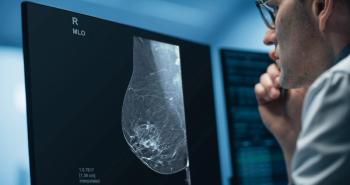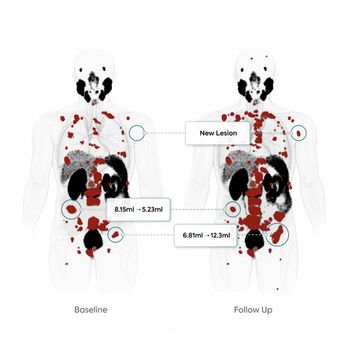
Imaging informatics: problem or solution?
Day-to-day radiology practice has changed immeasurably over the past 20 years. Many senior radiologists will no doubt recall how, as residents, they were asked to review 50 to 100 conventional x-rays each working day. Today, a single trauma patient can generate 1500 to 2000 images. As a result, if a dozen or so emergency cases arrive during the night shift, the resident on duty could be overwhelmed by more than 25,000 images to review.
Day-to-day radiology practice has changed immeasurably over the past 20 years. Many senior radiologists will no doubt recall how, as residents, they were asked to review 50 to 100 conventional x-rays each working day. Today, a single trauma patient can generate 1500 to 2000 images. As a result, if a dozen or so emergency cases arrive during the night shift, the resident on duty could be overwhelmed by more than 25,000 images to review.
With so much information to manage, it's little wonder that radiologists are spending more and more time glued to diagnostic monitors and less time engaging with patients. Radiology is becoming a 10 to 12-hour-a-day desk job. The mountain of data also places pressure on image transmission and storage systems. This in turn generates questions about what needs to be acquired and saved. Should every trauma patient receive a CT scan? Could chest CT slice thickness be reduced when imaging patients with chronic lung disease? Is it safe to save only reconstructed images instead of the entire raw data set?
Pointing out problems and dilemmas is easy. Finding a solution is less straightforward. While the rising tide of imaging informatics has created this situation, information technology may ultimately be the lifeboat that rescues radiologists.
During the 2005 editorial board meeting for Diagnostic Imaging Europe, two radiology leaders discussed the emerging role of IT in radiology in a lively exchange of views: Prof. Heinz Lemke, founder of the Computer Assisted Radiology and Surgery (CARS) congress and a research professor of radiology at the University of Southern California, Los Angeles, and Prof. Hans Ringertz, a professor of radiology at Stockholm's Karolinska Institute.
Lemke: It is true that in the future, there will be more and more radiological images produced, and this is due to advances in informatics. But solutions from informatics will also emerge to handle this increase in images. So radiologists need to keep aware of the possible solutions that are available. In fact, many systems-open systems-already exist to navigate through large numbers of images. Open-access software is very important. Even if radiologists have difficulty using it at first, they should at least be aware that the resources exist. We have to move in this direction. If radiology does not take advantage of what information and communication technologies can offer, then at the end of the day, the specialty will lose out.
Ringertz: Rather than developing computer systems to handle all these images, I am much more in favor of the so-called cookbook idea. We need "recipes" that dictate which images are actually needed. Many of the thousands of images being generated are because we, as radiologists, are trying to cover every single possibility in a scan. But to be honest, you could cover 95% of all pathologies with a quarter of the images.
This approach is being used by Prof. Stephen Golding at the University of Oxford, U.K. Radiologists there are scanning 60 patients per day with very short MRI programs. They have to call back 5% to 8% of patients, and rescan them with a couple of additional sequences. But the overall timeeconomy of the approach is extremely good. The rest of us are using too many sequences, and producing too many images. We need a smarter radiology cook book and a similar recall policy.
SERVICES TO SURGERY
Ringertz: A basic x-ray image used to be able to solve 80% of all radiological questions. But nobody is going back to using this equipment. That knowledge, used in making definitive diagnoses from plain film x-rays, is lost. Picture the situation as it used to be. A chest radiologist would be standing beside a surgeon who wants to know, "Should I operate or not?" In those days you couldn't say, "I suggest we do an MRI scan, or get the CT results," or "Have you checked this on ultrasound?" The radiologist had to answer with a straight yes or no. Radiologists who had to make these decisions soon learned.
Lemke: I am involved with a center in Germany that has been given five years of funding for image-guided surgery. The German government has put in over 10 million Euros to support research on image guidance and the relationship between radiology and surgery. Radiology needs to embrace initiatives like this and participate in them. It is time for radiology to take advantage of this movement that is bringing imaging together with surgery.
Ringertz: One idea would be to do joint outcome studies, to see the impact of this technology on patients. We could do this sort of work at academic institutions.
Lemke: I am working closely with surgeons in many disciplines. Surgeons are becoming more and more dependent on imaging in their preoperative planning, and also in the intraoperative execution of surgical procedures. They complain to me all the time that radiologists are not sufficiently supportive. Radiologists need to get involved, for example, in preparing large imaging data sets so they can be used for preoperative planning or fused with intraoperative data. Nobody is providing such a service. Radiology is not moving in, and surgeons cannot do it. It is not really a surgeon's job to work on images. I would like every hospital to have a group responsible for taking CT, MRI, and other digital imaging data and manipulating it.
Ringertz: But those data have already been acquired by a radiology department and analyzed by a radiologist who has produced a report.
Lemke: It is not enough. The issue in surgery is segmentation. You have to identify your objects, but there are no software algorithms that can do this. There is no way of automating identification of the difficult pathological structures that you see with your eye very easily. You can make a diagnostic decision very quickly. But to map the circumference of these objects, to describe them in 3D and 4D, that is a problem. And that is what surgeons need for image-guidance and navigation devices.
Ringertz: You mean you want some kind of drawing in the 3D space?
Lemke: Yes.
Ringertz: That is what radiologists are doing already.
Lemke: No they are not.
Ringertz: We do it on the 3D reconstructions or on the 2D series. We demonstrate what is tumor and what is edema.
Lemke: But you don't really segment the image. Segmentation means that you identify the circumference of the pathology slice by slice.
Ringertz: This would be the perfect task for radiology technicians [radiographers]. They love to explore all of these new tools. Some of the radiology technicians in our department are very good with computers. Training a subspecialty of computer-literate radiology technicians to do these 3D reconstructions would solve this problem.
Lemke: For segmentation, you need a medically trained person. It cannot be done by a radiographer or a computer scientist. Only the radiologist has the knowledge and experience to identify objects on images.
Ringertz: You would be surprised how much of this sort of work, for instance in oncology, is being done by the radiation physicists. They have the same problem. They need to see what is tumor and what is edema.
Lemke: Radiation oncology has a 30-year history of using computers. Surgery has none. It is only just moving into this area. Also, the surgical field is probably 10 or 20 times the size of radiation oncology. It is huge. I am just pointing out a business opportunity for radiology, which I think would be fantastic for the future. Such a service should be provided by a radiology department because radiologists are the imaging specialists. They have the knowledge of anatomy and pathology that is crucial to surgery. If you move into the body of a patient, you need that image-based knowledge. Who has it? Radiologists. Not computer scientists and not radiology technicians.
Ringertz: The Stanford department of radiology now has 10 people whose sole job is produce 3D images for clinicians.
Lemke: I know that surgeons in other hospitals would love to have this kind of service, too. But they don't get it. In Germany, for example, it is almost impossible at the moment to do what Stanford has done. It will be radiology that suffers in the end.
Ringertz: In the U.S., they are reimbursing for this kind of work. Radiologists charge for acquiring the images and interpreting them, that's two bills. Then there is another bill when, for instance, an orthopedist requests a 3D view of the hip in order to measure what type of prosthesis to fit in the socket.
Lemke: Then you have to fight for reimbursement, too. We had this situation about 10 years ago with PACS. There was a lot of hesitation and resistance. Now PACS is accepted. These multidimensional data sets are similar in that they will have a dramatic impact on radiology as well.
PACS has had a considerable impact on workflow, as we have seen. There are good things and bad things about PACS. Radiologists can now work online, which is a step forward, but they have lost their direct, personal connection with clinicians. That is not so good. But nobody can stop PACS, and nobody will be able to stop the increasing use of multidimensional data.
Newsletter
Stay at the forefront of radiology with the Diagnostic Imaging newsletter, delivering the latest news, clinical insights, and imaging advancements for today’s radiologists.





